The singular form of a word is used to express only one. The plural form of a word indicates more than one. For instance, you can have one car or several cars. Converting a word between these grammatical numbers is something that comes with experience. If you scroll down the page, you will find a ton of worksheets that help you learn how to use the correct grammatical quantifier in the sentences that you are writing. The worksheets explain how to change numerous singular words into words that describe more than one thing. One lesson describes how to tell whether to add an s or an es to the end of a sentence to create a plural version of a singular word. Another lesson teaches your kids about possessive words. Print out each worksheet to allow your students to develop grammar and phonics skills at home.
Printable Plural Worksheets
Click the buttons to print each worksheet and answer key.

Counting Nouns
Count each set of count nouns. Write the correct plural form of the noun on the line. Follow the example.

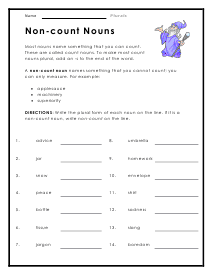
Non-count Nouns
Write the plural form of each noun on the line. If it is a non-count noun, write non-count on the line.
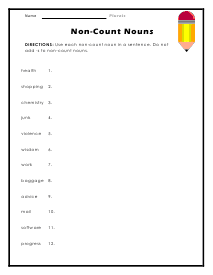
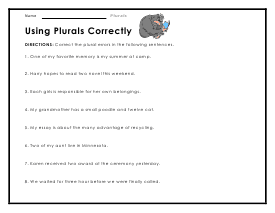
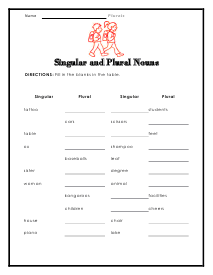
Singular and Plural Nouns
Fill in the blanks in the table. You will need to notice that there are two separate tasks going on within each of the rows.
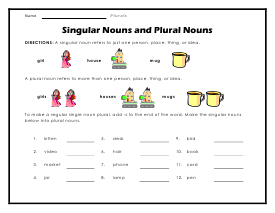
What Kind of Noun Are You?
To make a regular single noun plural, add -s to the end of the word. Make the singular nouns below into plural nouns.
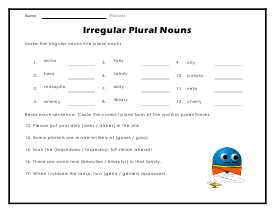
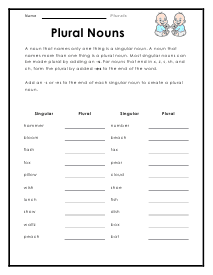
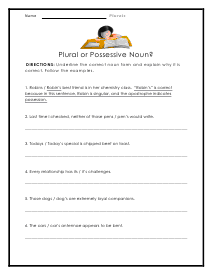
Plural or Possessive Noun?
Underline the correct noun form and explain why it is correct. Follow the examples.
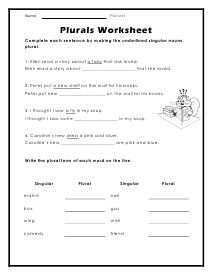
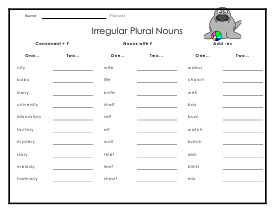
Irregular Plural Nouns
Consonant + Y, Nouns with F, Add -es. We practice placing these three concepts into words. As you can see, you will need to consider your approach on all of these.
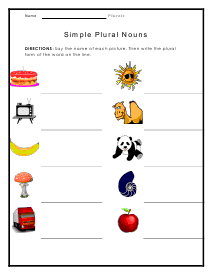
Simple Nouns
Say the name of each picture. On the line that is provided write a word that would mean many of those.
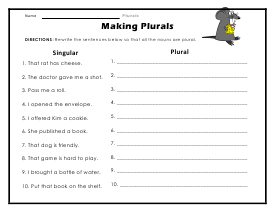
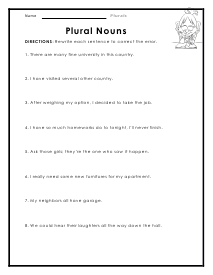
What Are Singulars and Plurals?
When writing in English, it's essential to know what are singulars and plurals. Singulars are individual items, while plurals are groups of things. We'll go over the rules for making use of these quantifiers in your use of language and give some examples of each. We'll also show you how to use them in sentences. So let's get started!
Plurals are way to express a quantity of more than one with grammar. If there is a quantity of only one for the noun, we are discussing we would use the singular version. For the most part singular and plural nouns look a great deal alike. In most cases, we are just adding an -s or -es ending. There are situations where grammar confuses us and leaves us scratching our heads. For example, the words deer and sheep are both the plural and the singular. This happens in many cases when we are referring to animals. The best way to learn the proper quantifier form of a word is just experience and repetition. English curriculum typically introduces the singular version of words to provide a solid foundation on which to place additional grammar and phonics building blocks.
These grammatical forms are both terms used to describe the forms of words. A singular word is a word that describes one thing, while a plural word is a word that represents more than one thing.
When it comes to grammar, there are three main ways to make a singular word into a plural word: by adding -s, by adding -es, or changing the word altogether. For example, the singular form of "cat" is changed to "cats" by adding -s, while the singular form of "fox" becomes "foxes" by adding -es. Meanwhile, the plural form of "child" is simply "children," and there are no -s or -es added to the end of the word.
The Foundational Rules
It's important to note that not all words follow these three rules. Some words remain unchanged when they become plural, such as "sheep" and "deer." Some words change in irregular ways, such as "man" (which becomes "men") and "woman" (which becomes "women").
When it comes to using singular and plural words correctly, there are a few key things to keep in mind:
1. First, remember that singular nouns take singular verbs, and plural nouns take plural verbs. For example, "The cat is sleeping" is correct, but "The cats is sleeping" would be incorrect.
2. Second, ensure that the pronoun you use agrees with the noun, whether singular or plural. For example, "She is a good cat" is correct, but "They are good cat" would be incorrect.
3. Finally, pay attention to the context of the sentence to make sure that the word you use makes sense. For example, saying "I have two dog" would not make sense because it would imply that you have two of the same dog.
Few Exceptions
Regarding grammar, there are a few rules that seem to be set in stone. One of those is the rule governing singular and plural nouns: singular nouns take singular verbs, and plural nouns take plural verbs. There are, however, a few exceptions to this rule.
1. One exception is when a plural noun is used to describe a single entity. This is often the case with collective nouns, such as team, jury, and family. For example, you would say, "The jury has reached a verdict," even though there are multiple jurors.
2. Another exception is when a plural noun is used in an idiomatic expression. For example, you would say, "The news is good," even though the word "news" is plural.
3. Finally, a few singular nouns are actually plural in meaning. These include words like criteria and data. For example, you would say, "These criteria must be met," even though the word "criteria" is singular.
Even though there are a few exceptions to the rule, singular and plural nouns usually take the same verb form. So, when in doubt, go with the singular verb. It's always better to be safe than sorry for grammar!
Wrapping Up
In general, singular and plural words are not too difficult to use once you get the hang of it. Remember to pay attention to whether the noun is singular or plural, and make sure that the pronoun and verb agree with the noun. You'll be using singular and plural words like a pro with a bit of practice!

